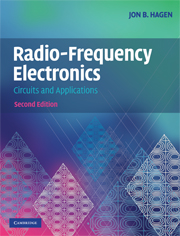Book contents
- Frontmatter
- Contents
- Preface
- 1 Introduction
- 2 Impedance matching
- 3 Linear power amplifiers
- 4 Basic filters
- 5 Frequency converters
- 6 Amplitude and frequency modulation
- 7 Radio receivers
- 8 Suppressed-carrier AM and quadrature AM (QAM)
- 9 Class-C, D, and E Power RF amplifiers
- 10 Transmission lines
- 11 Oscillators
- 12 Phase lock loops and synthesizers
- 13 Coupled-resonator bandpass filters
- 14 Transformers and baluns
- 15 Hybrid couplers
- 16 Waveguide circuits
- 17 Small-signal RF amplifiers
- 18 Demodulators and detectors
- 19 Television systems
- 20 Antennas and radio wave propagation
- 21 Radar
- 22 Digital modulation techniques
- 23 Modulation, noise, and information
- 24 Amplifier and oscillator noise analysis
- 25 The GPS Navigation system
- 26 Radio and radar astronomy
- 27 Radio spectrometry
- 28 S-parameter circuit analysis
- 29 Power supplies
- 30 RF test equipment
- Index
- References
28 - S-parameter circuit analysis
Published online by Cambridge University Press: 05 June 2012
- Frontmatter
- Contents
- Preface
- 1 Introduction
- 2 Impedance matching
- 3 Linear power amplifiers
- 4 Basic filters
- 5 Frequency converters
- 6 Amplitude and frequency modulation
- 7 Radio receivers
- 8 Suppressed-carrier AM and quadrature AM (QAM)
- 9 Class-C, D, and E Power RF amplifiers
- 10 Transmission lines
- 11 Oscillators
- 12 Phase lock loops and synthesizers
- 13 Coupled-resonator bandpass filters
- 14 Transformers and baluns
- 15 Hybrid couplers
- 16 Waveguide circuits
- 17 Small-signal RF amplifiers
- 18 Demodulators and detectors
- 19 Television systems
- 20 Antennas and radio wave propagation
- 21 Radar
- 22 Digital modulation techniques
- 23 Modulation, noise, and information
- 24 Amplifier and oscillator noise analysis
- 25 The GPS Navigation system
- 26 Radio and radar astronomy
- 27 Radio spectrometry
- 28 S-parameter circuit analysis
- 29 Power supplies
- 30 RF test equipment
- Index
- References
Summary
The S-parameter (scattering parameter) analysis technique for linear circuits has become the de facto standard in RF engineering, especially for microwave work, where it had its origins in WWII radar development. Physicists-turned-engineers, who were accustomed to analyzing the scattering (collisions) of atomic particles, used that term to describe the reflection and transmission of electromagnetic waves in electrical circuits. The resulting version of circuit theory, in terms of waves rather than currents and voltages, is convenient when working with circuits whose interconnections are transmission lines, especially when those lines are waveguides, where the definitions of voltage and current are somewhat arbitrary. The Smith chart, introduced in 1939, provided a familiar connection to the S-parameter method. In the 1960s, Hewlett Packard introduced the first network analyzers for direct S-parameter measurements.
S-parameter definitions
Keep in mind that the S parameters are just another set of transfer parameters, like the Y and Z parameters, to describe a linear circuit or circuit element at a given frequency. A two-port network is described equally well by its four complex Y parameters, its four complex Z parameters, or its four complex S parameters. Knowing one set of parameters, we can calculate any other set.
S parameter of a one-port network
A resistor, the simplest circuit element, can be described by a single parameter, its resistance, R, the ratio of voltage to current. It can be equally well described by its conductance, G, the ratio of current to voltage.
Information
- Type
- Chapter
- Information
- Radio-Frequency ElectronicsCircuits and Applications, pp. 390 - 405Publisher: Cambridge University PressPrint publication year: 2009
References
Accessibility standard: Unknown
Why this information is here
This section outlines the accessibility features of this content - including support for screen readers, full keyboard navigation and high-contrast display options. This may not be relevant for you.Accessibility Information
- 1
- Cited by
